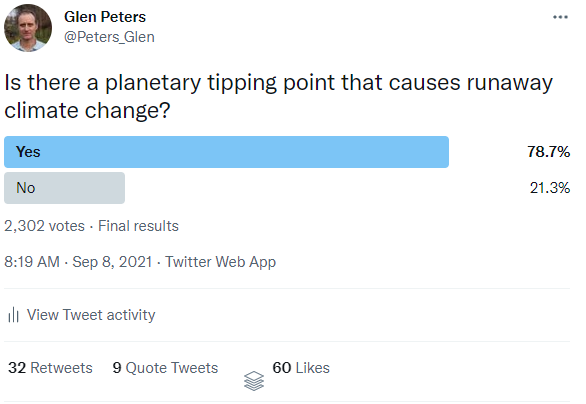“[W]e scientists carry a big responsibility in not spreading the wrong messages” @jrockstrom
3/4 answered “yes” to this question, but Rockström said “no” in an interview with @MLiebreich
The question is ambiguous, so let’s unpack it a bit.
cleaningup.live/ep49-johan-roc…
1/
3/4 answered “yes” to this question, but Rockström said “no” in an interview with @MLiebreich
The question is ambiguous, so let’s unpack it a bit.
cleaningup.live/ep49-johan-roc…
1/

“[Y]ou're absolutely right, that nobody is suggesting that there is a planetary tipping point out there that causes runaway climate change” @jrockstrom
[I used this to make the question in the Twitter poll]
2/
[I used this to make the question in the Twitter poll]
2/
That statement seems clear, but there are ambiguities:
* “a” or many?
* “planetary” or smaller scale?
* “runaway” or a new state?
These issues were common in yesterday’s discussion
3/
* “a” or many?
* “planetary” or smaller scale?
* “runaway” or a new state?
These issues were common in yesterday’s discussion
https://twitter.com/Peters_Glen/status/1435488027812548611
3/
“[T]here are very few scientists… suggesting that 1.5°C is a tipping point threshold… the science today shows that at 2°C, we are at risk of triggering tipping points. Not that the planet would tip but we are at risk of triggering a significant number of tipping points.”
4/
4/
“At 1.5°C, it's rather that the mainstream of science is that we will feel big impacts, we will have a lot of damage… three tipping points may be at risk already at 1.5°… I would say that 1.5 remains a kind of a high impact point” [not a tipping point threshold]
5/
5/
“[I]t's important to understand that it's not like one system tipping, it is a myriad of different systems interacting…”
[And these systems are not really planetary scale, but subsystems like Arctic, Amazon, Greenland, North Atlantic, etc.]
6/
[And these systems are not really planetary scale, but subsystems like Arctic, Amazon, Greenland, North Atlantic, etc.]
6/

“Nine out of these 15 systems are starting to show worrying signs, moving towards tipping points, not that they have crossed, but they show signs of either slowing down or higher variability” [quote simplified]
7/
7/
“I mean, it's a battery of systems, and they all churn and work to regulate the state of the planet. So it isn't one button that suddenly releases the whole system, no.”
8/
8/
“[T]he hothouse Earth paper … is essentially waved around as proof that we are tipping and that we're spiralling off… how do we as scientifically grounded people help to carry out this debate?”
@MLiebreich
pnas.org/content/115/33…
9/
@MLiebreich
pnas.org/content/115/33…
9/
Note the hothouse paper “uses the word 'could' 47 times 'might' eight times and 'may' 17 times & yet it gets trotted out as the definitive” @MLiebreich.
See also @richardabetts theconversation.com/hothouse-earth…
10/
See also @richardabetts theconversation.com/hothouse-earth…
10/
“[T]he hothouse Earth paper showed that if… we reach 2°C … that the planet will probably, or very likely, by itself increase temperatures to a further 0.4 to 0.5°C”
11/
11/
“[I]f you reach 2.5°C, we are at risk of triggering the next set of tipping point, which could lead to a cascade… that cascade could lead to a drift of warmer & warmer temperatures.”
[which sounds like a runaway to me, but I think a different state is meant]
12/
[which sounds like a runaway to me, but I think a different state is meant]
12/

“The impacts may come very far, the big let's call them catastrophic impacts, wouldn't play out until let's say 2,3,4 or 500 years in the future.”
13/
13/
Back to the poll & first tweet.
It is hard to know what 75% of respondents are thinking when they say there is a tipping point that leads to runaway climate change. But clearly, there are communication issues.
[It is also a Twitter poll, not science, so don't confuse that]
14/
It is hard to know what 75% of respondents are thinking when they say there is a tipping point that leads to runaway climate change. But clearly, there are communication issues.
[It is also a Twitter poll, not science, so don't confuse that]
14/
I think @jrockstrom is saying there are multiple interacting tipping points that could (at ~2°C) move the planet into a new state. Though, there are huge uncertainties.
Listen to the @MLCleaningUp podcast: cleaningup.live/ep49-johan-roc…
15/15
Listen to the @MLCleaningUp podcast: cleaningup.live/ep49-johan-roc…
15/15
And, for a more detailed discussion of runaway and related issues, see this thread
https://twitter.com/CColose/status/1436040625594454018
For what it is worth, I would have answered "no" in my original poll. I think about this much the same as Pierre.
https://twitter.com/PFriedling/status/1435587624987660293
• • •
Missing some Tweet in this thread? You can try to
force a refresh
























